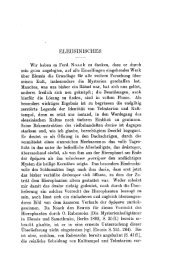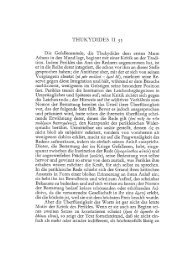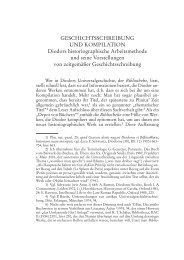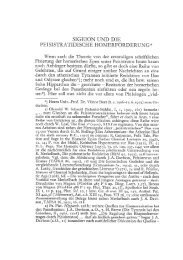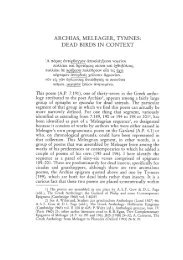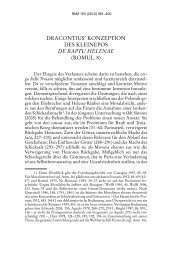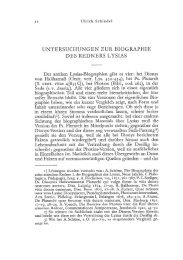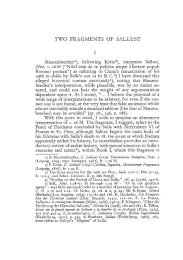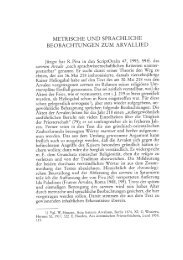APOTELESMATICA 2. (1) 14–140: SOURCES AND MODELS*
APOTELESMATICA 2. (1) 14–140: SOURCES AND MODELS*
APOTELESMATICA 2. (1) 14–140: SOURCES AND MODELS*
You also want an ePaper? Increase the reach of your titles
YUMPU automatically turns print PDFs into web optimized ePapers that Google loves.
66 Maria Ypsilanti<br />
are an introduction to the work, briefly displaying the celestial<br />
bodies, Sun, Moon, fixed stars and planets. In line 14 the author<br />
introduces the five planets whose phases and powers will constitute<br />
the theme of his epic and proceeds with the presentation of the<br />
sphere: axis, poles, celestial circles (18–140), before entering the<br />
main field of his interest, the astrological discussion. The present<br />
paper focuses on lines <strong>14–140</strong>, as these convey the astronomical<br />
information which enables us to examine them with reference to<br />
scientific sources. More specifically the discussion intends to<br />
demonstrate the influence of Aratus’ Phaenomena on these lines,<br />
and will also trace, to the extent that the extant evidence renders it<br />
possible, the poet’s use of other sources for the presentation of the<br />
constellations in them.<br />
The author is inspired by Aratus, deviating from the presentation<br />
of the constellations in his model, however, in numerous<br />
details; it will be shown that for the composition of this part of his<br />
poem Pseudo-Manetho used a globe, like many astronomical<br />
authors of Antiquity. 3 The unremitting popularity of the usage of<br />
globes even in later times is most eloquently expressed by the<br />
rewriting of the Aratean lines about the constellations of the three<br />
celestial circles (tropic of Cancer and Capricorn, Equator) by the<br />
Byzantine scholar Maximus Planudes (1255–1305), in his revision<br />
ledge of Dorotheus is evident for instance in Hephestion Thebaeus, who composed<br />
three books of Apotelesmatica at c. A. D. 415, Rhetorius Aegyptius, various Byzantine<br />
astrologers, see Pingree xii f.<br />
3) For a discussion of this likelihood for Manilius, Germanicus, Hyginus,<br />
Achilles, among others, see Thiele 45 ff., Schlachter 23, 27 ff., le Bœuffle (1975) xxii,<br />
id. (1983) x ff. Statues, coins, gems and other works of art depicting globes have survived,<br />
see Gundel passim: for the first century B. C. to first century A. D. for instance<br />
281 n. 264, 291 n. 329, 293 n. 314, and passim. For a discussion of the<br />
sphaeropoiia in Antiquity see Aujac (1993, La Sphéropée) 157–71. A whole marble<br />
globe in a relatively good condition, with the celestial circles and the constellations<br />
on them in relief is the Atlas Farnese globe, an Adrian-age copy of an original of<br />
the third quarter of the first century B. C., see Thiele Taf. II–VI, Gundel 204,<br />
207 n. 8. Thiele has argued that it is Hipparchus’ globe that the artist of the globe<br />
Farnese copied or at least based his work on, see Thiele 27 ff. For the popularity of<br />
globes and other artefacts representing the sky in Antiquity, cf. for instance the epigram<br />
which accompanies the celestial globe the poet Leonidas of Alexandria offers<br />
to Poppaea (AP 9.355) and the pair of cups decorated with constellations offered as<br />
a present to Piso (Antip. Thess. AP 9.541), with the help of which the receiver “no<br />
longer needs to look up Aratus”, l. 5. Ancient sources again state, inter alia, that<br />
globes where indeed necessary for the readers’ understanding of Aratus, see<br />
Schlachter 21 ff.



